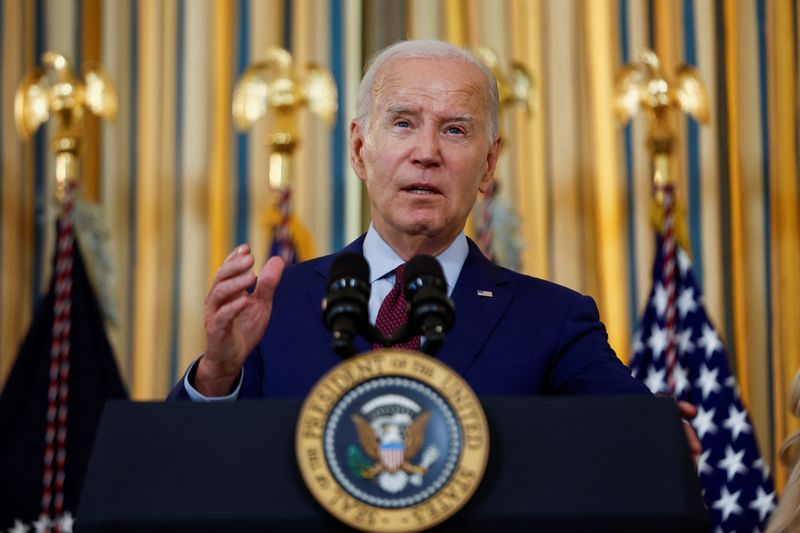Biden’s tough sell in Pennsylvania: green energy to union workers
2023.07.20 05:29

© Reuters. U.S. President Joe Biden speaks as he convenes a meeting of the White House Competition Council in the State Dining room at the White House in Washington, U.S., July 19, 2023. REUTERS/Evelyn Hockstein
By Jarrett Renshaw
PHILADELPHIA (Reuters) – President Joe Biden travels on Thursday to Philadelphia to pitch the promise of a green economy to union workers skeptical that the solar, wind and electric vehicle industries can deliver the same economic punch for organized labor as fossil fuel-powered refineries and power plants.
Biden is trying to reshape the U.S. economy by investing billions of taxpayer dollars in green technology, while forcing companies that want lucrative subsidies being offered to help the push do more of their manufacturing in the U.S.
He will visit the Philadelphia Shipyard to attend the steel-cutting ceremony for the Acadia, a union-built vessel that will be used to help build offshore wind farms. Biden is betting that union workers whose jobs are threatened by the energy transition will eventually find a place in the green economy, but that’s a hard sell in union-friendly Philadelphia.
About a dozen union workers in the Philadelphia region Reuters spoke to questioned whether the new industries can produce a similar number of jobs at the same high wage scale.
They may have good reason to worry.
Roughly 80% of the more than 50 EV battery, solar panel and other factories announced since passage of the Inflation Reduction Act in August are in states with laws that make it harder for workers to unionize, a Reuters analysis published this year found.
Nancy Minor, 57, worked as a union operator at a Philadelphia’s largest and oldest refinery for nearly three decades before it shut after a 2019 explosion. Now a refinery safety consultant, she made enough money to buy a house, raise her kids as a single mother and send them to private school.
She worries clean energy projects like solar and wind farms, along with hydrogen pipelines, oversell and under deliver when it comes to long-term, full-time employment.
“The initial promise of jobs is spectacular but after the equipment is built they can run it with a fraction of the people,” Minor said.
‘HOW MANY JOBS?’
Overall energy jobs in the U.S. grew 3.8% in 2022, to more than 8.1 million, led by fast growth in clean energy jobs, the Department of Energy said in June. Clean energy jobs, a wide category including wind and solar power, nuclear, and grid technologies and battery storage, made up 3.1 million of those.
Ali Zaidi, Biden’s national climate adviser, says the president is pushing to make sure unions are part of the energy transition, and to get unions and companies working together.
Unions will benefit from an expanded power grid, a boom in manufacturing from clean energy supply chains and new industries like hydrogen, Zaidi said, noting Danish renewable energy group Ørsted’s partnership North America’s Building Trades Unions.
Pat Eiding, long-time president and current treasurer of Philadelphia AFL-CIO Council, said a rash of refinery closures in the region over the past two decades crushed some local unions. Many of those laid off workers struggled to find similar paying jobs and he fears the same for any worker hurt by the energy transition.
Eiding also believes the green economy will struggle to replicate the employment from refineries and power plants, which require 24-hour, 365-day staffing and significant annual maintenance.
“I believe Biden when he says that green energy jobs will be union, the question is just how many jobs will there be,” Eiding said.
Seth Harris, who previously served as Biden’s top labor policy adviser at the White House, said unions have made progress in some green industries, like agreeing contracts for wind farms, but are still struggling to get a foothold in a solar industry dominated by China.
The Biden administration has pushed new funds to help workers like coal miners find new jobs, but more can be done, Harris said, including increased investment in community colleges and apprenticeship programs.
“The labor movement has legitimate cause for concern and they are aggressively in discussions with Congress and with the White House about how to make certain that current members have the opportunity to be represented by a union and to have good quality jobs as a result,” Harris said.








